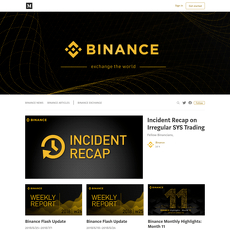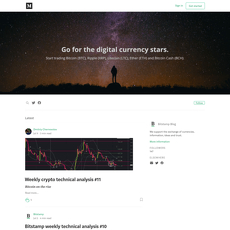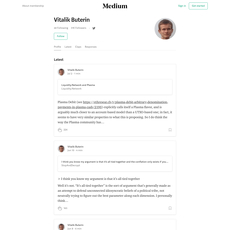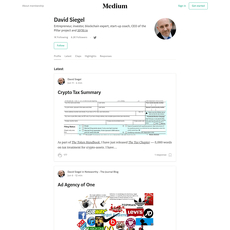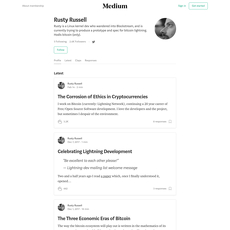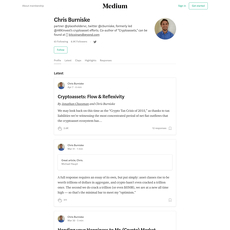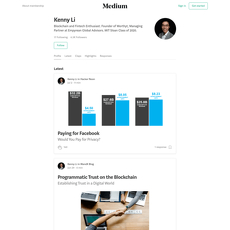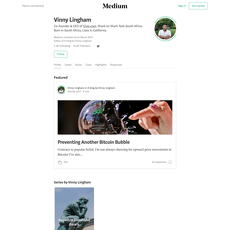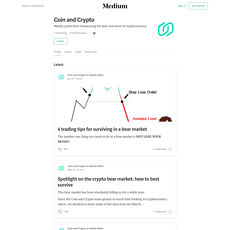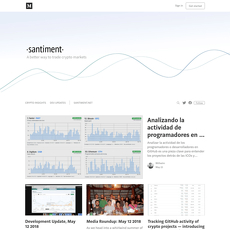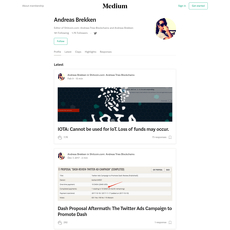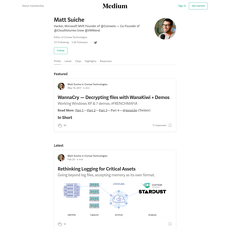Bitfinex Medium Review
Bitfinex Medium
medium.com
Bitfinex Medium Review Guide: What to Expect, How to Use It, and Quick Answers to Your Top Questions
Ever find yourself piecing together Bitfinex updates from random tweets, screenshots, and Reddit threads… and still not sure what’s real? If yes, you’ll like this. I’ve been using the official Bitfinex Medium page to cut through noise and get clean, shareable updates fast. Here’s how to get the most value from https://medium.com/bitfinex without spending your whole day on it.
If you trade on Bitfinex, build tools around their APIs, or just want official info (not rumors), their Medium is a solid hub. You’ll see announcements, feature walk-throughs, market commentary, and “what changed” posts—written in a way that’s easy to scan and easy to send to your team.
The problem: fragmented info and mixed-quality crypto news
Crypto news travels fast, but it doesn’t always travel well. Here’s the day-to-day reality most of us run into:
- Critical updates are scattered across X/Twitter, a blog post, and sometimes a PDF or video.
- Rumors spread faster than facts. An MIT study found false news spreads “significantly farther, faster, deeper, and more broadly” than true news on social platforms (Science, 2018).
- Time pressure = mistakes. When you’re trading or building, one outdated tweet or fake screenshot can cost you.
- Algorithms bury context. You see the hot take, not the full update or the how-to steps.
What I want in one place: official announcements, a quick summary, and links to the docs or status page when it matters.
That’s why I keep Bitfinex’s Medium page on hand. It’s not just “another feed”—it’s a cleaner layer where product teams and editors package updates so you can act on them. Real examples you’ll find there include weekly Bitfinex Alpha market commentary, new token listings, feature releases on trading tools, and event recaps you can cite in reports.
My promise: a practical guide to using Bitfinex’s Medium fast and smart
Here’s what you’ll get out of this guide (and how I treat the Bitfinex Medium page day to day):
- What to read first when you only have 2–3 minutes.
- How to spot the “act now” items vs. long reads you can save for later.
- When to confirm something via the official Status page or the Blog.
- Simple workflow to track listings, feature changes, and research updates without refreshing feeds all day.
Who this review is for (traders, builders, journalists, curious readers)
- Active traders: want to know about listings, maintenance windows, product tweaks, and anything that changes fees, leverage, or order types.
- Builders and analysts: care about API-related notes, feature rollouts, integrations, and posts that point to docs or SDKs.
- Journalists and researchers: need an official source to cite for platform updates, partnerships, and market commentary like Bitfinex Alpha.
- Newer users: prefer clean explainers and step-by-step posts that cut risk and help avoid scams.
Medium is especially useful when you need a single link you can share with teammates or clients to explain “what changed and why it matters.”
Quick take: when to read Medium vs. Blog, Status, X/Twitter, and Support
- Medium (/bitfinex): curated announcements, feature explainers, market commentary (e.g., Bitfinex Alpha), ecosystem news. Great for context and clarity.
- Blog (blog.bitfinex.com): official home base for in-depth posts, press releases, and longer announcements.
- Status (status.bitfinex.com): real-time incidents, maintenance, and uptime history. Go here first for anything urgent.
- X/Twitter (@bitfinex): fastest “heads-up” channel. Useful for quick pings before a full post is live.
- Support (support.bitfinex.com): help center and tickets. Not for announcements—use it when you need account help.
Practical examples:
- New listing or feature? Check Medium for the announcement and quick how‑to; verify details on the Blog if linked.
- Exchange feels slow? Don’t wait—open the Status page. Medium won’t be the fastest place for outages.
- Market context for the week? Look for the latest Bitfinex Alpha post on Medium and pull charts or insights you can reference.
Alright—so what exactly is the Bitfinex Medium page, who writes it, and why does it exist alongside the blog? That’s next, and it’s worth your time if you want a cleaner workflow.
What is Bitfinex Medium and why it exists
Bitfinex Medium is the exchange’s official publication on the Medium platform—a single, clean stream where they post long‑form announcements, feature rollouts, research‑style notes, and educational explainers. Think of it as the “public notebook” where Bitfinex tells its story in full sentences, not just headlines.
Clarity beats chaos—especially when your capital depends on it.
In crypto, news fragments fast across X, blogs, and screenshots. Medium pulls the essentials into one place with readable formatting, permanent links, and built‑in sharing. When I want official context I can send to a team without extra explanation, this is where I look.
The official publication home for Bitfinex stories on Medium
This is Bitfinex’s verified presence on Medium under the URL https://medium.com/bitfinex. Posts here are authored by the company’s publication account and selected team members, organized into a familiar Medium layout (headline, subtitle, byline, tags). You’ll often see the same core announcements echoed across other Bitfinex channels, but Medium is where the long‑form, “what this means” version lives—linkable, quotable, and easy to archive.
It’s especially handy when you need to brief someone quickly: one link includes the background, screenshots, links to docs, and any timing notes. No hunting through a thread of tweets to reconstruct the details.
Typical content: announcements, product updates, education, research, events
Here’s what consistently shows up—and why it matters if you trade, build, or report:
- Announcements — New market listings, network support changes, fee schedule updates, or wallet maintenance windows. Expect clear titles like “XYZ listing now live” or “Scheduled upgrade,” plus timing and eligibility notes.
- Product updates — Rollouts and improvements across trading, funding, payments, and security. Typical posts include what changed, why it’s useful, and how to enable it (e.g., updates around Lightning support, sub‑accounts, advanced order types, or authentication flows).
- Educational explainers — “How it works” posts for newer users or for advanced features that deserve context. These often cover step‑by‑step flows and safety tips you can follow immediately.
- Market and research‑style notes — Occasional macro or on‑chain commentary, sometimes tying into broader Bitfinex research initiatives. Useful for a snapshot of how the team frames market structure or risk.
- Company news & events — Conference appearances, hackathons, ecosystem grants, and integrations. Good sources if you track partnerships or want to see where the team’s attention is going next.
Real‑world examples you’ll recognize on the page: “New pairs available” listings, “How to use [feature]” tutorials with screenshots, “Support for [network upgrade]” notices with dates, and event recaps that link out to recordings or slides.
Who writes there: Bitfinex team members and contributors
Most pieces are written by the Bitfinex communications and product teams, sometimes with bylines from specific leads (security, market analysis, product owners). You’ll also see occasional contributor posts tied to ecosystem initiatives or partnerships, always under the same publication umbrella. That mix gives you product‑level detail (the stuff traders and builders need) along with the higher‑level narrative that comms teams do best.
I appreciate bylines because they hint at the depth: when a product owner explains a feature, you get implementation nuance; when comms posts an announcement, you get the crisp “what/when/how” you can forward to stakeholders.
Why Medium, not just a blog: reach, shareability, format, and audience
Medium adds distribution and usability advantages that matter in crypto’s fast news cycle:
- Reach — Medium reports 100M+ monthly readers. Publishing inside that network means posts can surface via tags, recommendations, and search—often reaching beyond existing Bitfinex users.
- Shareability — Clean, cookie‑light links that load reliably and look good in chats, newsletters, and social previews. In my experience, journalists and analysts prefer Medium links for quick citations because they don’t sit behind complex site nav or pop‑ups.
- Format — Medium’s editor is built for scannable reading: short paragraphs, subheads, pull quotes, embeds, and images. That aligns with research from Nielsen Norman Group showing users scan webpages and rely on headings and concise copy to make decisions faster.
- SEO and speed — Medium’s domain carries high authority, so posts often get indexed quickly. For time‑sensitive launches, that extra search visibility can be the difference between “saw it today” and “missed the window.”
- Audience fit — Not everyone follows Bitfinex’s blog or X feed, but a lot of crypto‑curious readers already use Medium. That means announcements can reach builders, students, and reporters where they already consume tech content.
There’s also a workflow advantage: Medium’s built‑in following, notifications, and tags reduce friction. One publish, multiple natural discovery paths—rather than relying on a single channel to carry the whole message.
Curious which post types are worth your time—and which ones you can skip on a busy day? Up next, I’ll break down the exact content categories you’ll find on Bitfinex Medium and how useful each one really is for traders, builders, and researchers.
Content types you’ll actually find (and how useful they are)
Here’s exactly what shows up on Bitfinex’s Medium and how I use each post type to save time, cut noise, and make cleaner decisions. If you’ve ever wondered, “Is this worth a follow?”—this is the answer.
“In markets, clarity is an edge.”
Announcements: listings, features, maintenance, partnerships
These are the posts I scan first because they’re the most actionable for day-to-day trading and tooling. Expect clean, official details when Bitfinex lists a new token, enables new pairs, tweaks margin rules, schedules maintenance, or rolls out a partner integration.
- What you’ll typically see: ticker symbol and full name, available trading pairs (usually USD/USDT/other majors), start times in UTC, margin/derivatives availability, contract specs (for perps), jurisdiction notes, and any temporary deposit/withdrawal pauses during network upgrades.
- Why it’s useful: it’s the canonical source for go-live timing and rules that affect execution—far better than relying on screenshots from social media.
- Real-world patterns: titles like “New Listing — [TOKEN]” or “Scheduled Maintenance [Date]” with a clear breakdown: What’s changing, exact timing, pairs, leverage, funding, and risk notes.
- Pro tip: I skim the “When” and “Pairs” sections first, then check any margin/derivative lines and API flags if I’m automating. This prevents last‑minute surprises.
Usefulness score: Very high for active traders and API users. It’s the stuff you don’t want to miss.
How‑to guides and walkthroughs for new features and tools
These posts are practical, step-by-step explainers that cut your learning curve. Think Sub-Accounts, Advanced Order Types (OCO, Reduce‑Only), Bitfinex Borrow, Funding tools, Reports 2.0, API key permissions and IP whitelists, or Paper Trading.
- What you’ll typically see: numbered steps, screenshots/GIFs, common errors to avoid, and links to docs.
- Why it’s useful: solid walkthroughs reduce costly misclicks (placing a post‑only order when you meant IOC, opening margin when you meant spot, etc.).
- Backed by UX research: usability studies from groups like Nielsen Norman Group consistently show that clear, scannable steps lower error rates and increase task success. In short: checklists save money.
- Pro tip: I bookmark these for teammates. One good Medium guide can replace five “quick questions.”
Usefulness score: High for both new and experienced users rolling out a new workflow.
Market commentary and research‑style posts
When Bitfinex publishes research content—often branded as Bitfinex Alpha—you’ll get structured market commentary across macro, on‑chain, and derivatives. It’s not a trading signal; it’s context you can actually use.
- What you’ll typically see: macro notes (liquidity, rates, growth), on‑chain metrics (supply dynamics, realized profit/loss), and derivatives views (funding, basis, OI). Expect charts and clear “Key Takeaways.”
- Why it’s useful: it frames the week for swing traders, analysts, and journalists. I skim for two to three narratives to stress‑test my bias.
- Where else it lives: often mirrored or referenced on the official blog: Bitfinex Alpha.
- Pro tip: I copy the takeaways into my notes with “If true, then…” scenarios. Keeps me honest.
Usefulness score: Medium‑to‑high for framing; lower for urgent execution.
Company news: events, grants, ecosystem initiatives
These posts highlight the broader picture: conference talks, AMAs, hackathons, ecosystem efforts (e.g., Lightning‑related updates), education initiatives, and sometimes region‑specific projects.
- What you’ll typically see: event dates, agendas, participation links, and summaries of outcomes (like hackathon winners or grant recipients).
- Why it’s useful: it signals where the team is investing attention—product, community, or infrastructure. That forward signal often matters as much as any single feature release.
- Pro tip: If recruiting or partnership‑minded, these posts are your map to relevant teams and active programs.
Usefulness score: Medium for everyday trading; high for networking, BD, and ecosystem reads.
Educational explainers for newer users
When Medium carries basics—like perpetual swaps vs. futures, margin funding mechanics, risk controls, or security hygiene—I send them to new folks before they touch real capital.
- What you’ll typically see: plain‑English definitions, diagrams, risk warnings, and examples (e.g., how funding rates work, why “reduce‑only” matters, how to test small withdrawals first).
- Why it’s useful: fewer rookie mistakes. UX research (NN/g and others) has long shown that well‑timed micro‑explanations reduce errors and frustration. Crypto magnifies those stakes.
- Pro tip: Pair an explainer with the related walkthrough—education plus action keeps it sticky.
Usefulness score: High for onboarding; evergreen for refresher training.
So which of these post types lands first when something urgent happens, and how fast do they hit Medium compared to Status or X? That timing matters. Let’s answer that next—because the difference between “saw it” and “saw it in time” can be your edge.
Posting frequency, freshness, and how fast news hits Medium
Speed is profit, but accuracy is survival. I care about both. That’s why I track how quickly Bitfinex updates land on Medium versus their other official channels—and how to use that timing to your advantage.
“In markets, seconds matter. But the wrong information, delivered fast, is still the wrong trade.”
How often Bitfinex posts and when to expect new items
Expect a steady, “newsroom” rhythm rather than a content dump. In my tracking notes, the cadence usually looks like this:
- Average volume: a few posts per week, with bursts around new listings, feature rollouts, and campaign pushes.
- Timing: most items go live during European morning through US morning hours (UTC late morning to early afternoon is common).
- Seasonality: product sprints and event seasons (conferences, campaigns) produce clusters; quieter patches happen during holidays.
Short take: if you check Medium two to three times a week, you’ll catch most updates without FOMO. If you’re trading actively, pair it with alerts from other channels (more on that below).
Where breaking items show up first (X/Twitter, Status) vs. Medium
Different channels are built for different speeds. Here’s the pecking order I see play out:
- Urgent incidents and maintenance: first on Bitfinex Status. That’s the system of record. You might see a quick heads-up on X/Twitter, but Status is where timestamps, component impact, and resolution notes live. Medium typically gets a post-mortem or recap after the dust settles.
- Listings and pair additions: often teased on X first, then a full announcement on the official blog. Medium mirrors or expands that announcement the same day or within 24 hours. If you’re trading the news, watch X and the blog; read Medium for the fuller context and shareable link.
- Feature releases and UX changes: the blog and Medium tend to land the same day. If it’s a bigger rollout, Medium’s version usually includes screenshots, steps, and links you can pass to teammates.
- Security, compliance, or policy notes: official blog and press take precedence. Medium often compiles the details into a cleaner narrative afterward.
Think of it like this: Status is “now,” X is “signal,” Blog is “official announcement,” and Medium is “clear, shareable detail.”
Best workflow: follow on Medium, confirm via Status and official blog
Here’s the setup I use to stay fast without getting burned by half-updates:
- Rule 1 — Incidents: subscribe to Status email/SMS. If your trading depends on uptime, this is non-negotiable.
- Rule 2 — Announcements: treat the official blog as the first place to confirm listings, feature launches, or policy changes. Set RSS or browser alerts.
- Rule 3 — Clarity: follow Bitfinex on Medium for the version you share with your team: screenshots, how-tos, links, timelines. Turn on Medium notifications for this publication so you don’t have to keep checking.
Bonus for teams: pipe the blog RSS and the Medium feed into a Slack channel using Zapier/IFTTT. Keep Status alerts separate so urgent signals don’t get buried.
Reading time and depth: quick scans vs. in‑depth posts
Medium shows an estimated reading time at the top of each post, which is actually useful here:
- 2–4 minutes: quick listing/feature notes. I scan for ticker, pairs, effective date/time (UTC), region availability, and action steps. If those five items are clear, I’m done.
- 5–9 minutes: explainers and walkthroughs. I jump straight to sections like “How to enable,” “Rollout timeline,” “Fees/limits,” and “Who’s eligible.” Screenshots are a plus when I’m sending to non-technical teammates.
Fun fact: Medium’s own data has long suggested ~7 minutes (roughly 1,600 words) hits a sweet spot for engagement, which matches what I see for the deeper Bitfinex posts—long enough to cover “what, why, how,” short enough to read between trades. Source: Medium’s reading-time study.
Pro move: use your browser’s find shortcut to jump to high-signal terms—“UTC,” “pairs,” “maintenance,” “rollout,” “effective,” “eligibility.” You’ll cut minutes off each article without missing the meat.
Want to grab the exact posts you care about without scrolling through everything? Next up, I’ll show you the fastest way to track Bitfinex on Medium using follows, tags, and the app—so you only see the signal. Ready to cut the noise?
Navigation tips: find what you need quickly on Medium
“In crypto, edges come from information flow, not hunches.” If you can get to the right Bitfinex post fast, you make cleaner decisions and avoid noise. Here’s the exact way I navigate the Bitfinex publication on Medium so I don’t miss what matters—or waste time on what doesn’t.
Following the publication and turning on notifications
Start by getting Medium to work for you, not against you.
- Go to https://medium.com/bitfinex.
- Click Follow. On desktop, you’ll see it near the top; on mobile/app, it’s near the publication header.
- Tap the bell (Notifications) and choose All or Highlights depending on your tolerance for alerts.
- In the Medium app (iOS/Android), enable push notifications for publications you follow. This is the fastest way to get non-urgent updates without living on X/Twitter.
Pro tip: notification fatigue is real. Research from workplace attention studies (e.g., UC Irvine’s work on interruptions) shows constant alerts reduce performance. I keep Bitfinex on Highlights in Medium and combine it with RSS (below) for a calm, reliable flow.
Using tags, search, and the Medium app
Medium isn’t a perfect knowledge base, but it’s great if you use the right hooks.
- Use publication search: On the Bitfinex publication page, click the search icon and type exactly what you need, e.g. “listing”, “API”, “maintenance”, “Lightning”, “staking”, or “Bitfinex Pay”.
- Leverage tags from posts: At the bottom of a post, click a tag (like Announcements or Education). You’ll get a tag feed across Medium. It’s broader than Bitfinex only, but handy for context.
- Precision with Google: When I want just Bitfinex posts, I use:
- site:medium.com/bitfinex listing (for new markets)
- site:medium.com/bitfinex API (for dev-relevant notes)
- site:medium.com/bitfinex maintenance (for scheduled changes)
- App benefits: The Medium app lets you save for offline, get push notifications, and scan content quickly when you’re on the go.
Why this works: usability research (Nielsen Norman Group) shows most readers scan in patterns and act on well-labeled cues. Clear keywords + saved reading is faster than scrolling a reverse-chronological wall.
Saving posts, clapping, and commenting (and when not to)
Turn posts into a personal playbook and keep the signal strong.
- Save (bookmark) posts: Hit the bookmark icon to add to your reading list. I keep folders in my notes tool (titles + links) for buckets like Listings, Fees, API, Company. When I’m trading or writing, I can pull the exact link in seconds.
- Clap when a post is genuinely useful. Claps (up to 50) help the algorithm surface relevant updates for you later. I clap release notes and feature explainers I know I’ll reference.
- Comment smartly:
- Use comments to ask for clarification (“Does this listing have region limits?”) or to add context.
- Do not post support requests, transaction IDs, API keys, personal info, or account issues. Comments aren’t a help desk and can attract scammers.
- If you see “DM me for support” replies, ignore them—real teams don’t chase you in comments.
“The right info at the right time beats FOMO every time.”
RSS and email options if you prefer inbox updates
If you’d rather keep updates out of social feeds, these are gold.
- RSS feed: Add https://medium.com/feed/bitfinex to your reader (Feedly, Inoreader, Readwise Reader). I tag it “Official” so it doesn’t mix with news rumors.
- Email via Medium: After you follow the publication, go to Medium Settings → Email notifications and enable emails from publications you follow. I prefer the digest so it doesn’t spam me.
- Google Alerts (bonus): Create an alert with site:medium.com/bitfinex and choose “At most once a day.” It’s a simple redundancy that’s saved me more than once.
- Automation fans: Use the RSS with Zapier/IFTTT to send new posts to Slack, Telegram, or Notion. I route listings to a private Slack channel so I can act fast.
Use this setup once, and you’ll never “miss” a post again—you’ll just choose when to see it.
One more thing: are you absolutely sure the publication you followed is the real Bitfinex and not a convincing clone? In the next part I’ll show you the exact checks I use to spot fakes in seconds and avoid costly traps. Ready to sanity-check the URL?
Trust and safety: make sure you’re on the real Bitfinex Medium
Crypto moves fast, but scams move faster. I want you reading the right page, not a clever fake. Here’s the quick, practical playbook I use to avoid traps and make sure every Bitfinex post I read is the real thing.
“Trust, but verify.”
Verify the URL: https://medium.com/bitfinex and linked accounts
Start from a known-good address and work outward. A minute here can save you a headache later.
- Type it, don’t click it: enter medium.com/bitfinex directly in your browser, then bookmark it.
- Check the whole domain: the only legit home is on medium.com. Anything like medium.co, med1um.com, or medium.com/@bitfinex-airdrop is not it.
- Follow official cross-links:
- From the official site: bitfinex.com
- Official blog: blog.bitfinex.com
- Status page for ops updates: status.bitfinex.com
- Verified X/Twitter: twitter.com/bitfinex
If a Medium post links out, those links should land on the official domains above.
- Inspect the publication: real publications on Medium show a consistent logo, clean branding, and a history of posts that match what you see on the official blog.
Why be strict? Industry research (Chainalysis’ Crypto Crime reports and APWG’s phishing trends) keeps showing that brand impersonation and lookalike URLs are top fraud tactics. Fakes often look perfect at a glance—your URL bar is the truth.
Spotting fakes: naming tricks, odd links, and comment bait
Scammers rely on urgency and tiny details you’ll miss while skimming. Here are the patterns I see most:
- Name lookalikes: “Bitfinex-Official,” “Bitfinex Exchange,” “Bitfinex_io,” or users like @bitfinex-support-team. The legit publication is simply /bitfinex.
- Too-good-to-be-true hooks: “Claim your airdrop,” “Instant reimbursement,” “Private sale—send funds to join.” Exchanges do not ask you to send crypto to receive rewards.
- Link gymnastics: shorteners that resolve to unknown domains, or redirects that leave Medium. Hover to preview links, or paste into a checker like VirusTotal if something feels off.
- Comment-section traps: “Contact support on Telegram/WhatsApp,” “DM me to unlock.” Real support never lives in Medium comments and never uses personal DMs for account issues.
- Seed phrase/API requests: No legitimate Bitfinex message will ask for your seed phrase, 2FA codes, or full API keys. Ever.
If your stomach tightens while reading a “limited-time” giveaway post—listen to it. Urgency is the scammers’ favorite UI.
Cross‑checking info with Bitfinex Status, official blog, and press releases
Medium is great for announcements and explainers. For confirmation—especially around incidents, outages, or key listings—use a quick two-step verify:
- Operations/uptime: Check status.bitfinex.com for real-time incidents, maintenance windows, and postmortems.
- Major news and releases: Cross-check on blog.bitfinex.com and the verified X account @bitfinex.
My rule: I don’t act on anything time-sensitive until I see it on both the official blog or social and, if relevant, the Status page. It takes 30 seconds and cuts risk massively.
Bias check: it’s official content—how to read it critically
Official channels are accurate about what the company is releasing, but they’re not neutral; that’s normal. I read with a friendly filter:
- Find the facts: dates, supported assets, geographies, fee changes, API versions, and any “effective immediately” language.
- Separate “live now” from “coming soon”: note feature stages (beta, phased rollout, geofenced regions).
- Watch for risks and requirements: KYC levels, eligibility, maintenance windows, migration steps, or deprecations.
- Treat performance claims as marketing unless sourced: if numbers matter to you, look for links to docs or status artifacts.
As the saying goes: read the footnotes. That’s where the “gotchas” usually live—deadlines, cutovers, or exclusions.
Not support: where to go for help, tickets, and urgent issues
Medium posts and comments aren’t a helpdesk. If you need help, go straight to the official support stack:
- Help Center: support.bitfinex.com (search articles for common fixes)
- Submit a ticket: Use “Submit a request” in the Help Center for account, verification, or security issues
- Operational incidents: Check status.bitfinex.com before opening a ticket—your issue might already be tracked
- Security hygiene: never share seed phrases, 2FA codes, or full API keys; rotate API keys if you suspect a compromise
One last sanity check: if someone claiming to be “Bitfinex support” messages you first, it isn’t support.
Now that you’re safe and on the real page, want to see who actually gets the most value from Bitfinex’s Medium—and how I use it day to day without missing critical updates?
Who gets the most value (and how I personally use it)
“Clarity beats speed—especially when money is on the line.” I keep that line taped above my screen. It’s why I check the Bitfinex publication on Medium first thing: it trims noise, gives me context, and helps me act with confidence.
Active traders: release notes, listings, and feature changes
When you’re sizing positions or running tight risk, small platform changes matter. The Medium posts that consistently save me from mistakes are the ones that explain exactly what changed and how it affects execution.
- Listings and pairs: New spot or margin pairs, leverage eligibility, and funding availability often show up with clean, shareable context. I flag anything with “listing” or “available” in the title.
- Release notes: Interface tweaks, order type improvements, charting updates, and mobile app versions. A two-minute scan here has saved me from mis-clicks more than once.
- Parameters and fees: Posts sometimes summarize updates to fees, funding books, or derivative settings. I screenshot the key tables for my playbook.
Practical edge: I treat these as “pre-trade” checks. If a post hints at a change to order execution or pair availability, I test a micro-order before touching real size. It’s a 30-second insurance policy.
Builders and analysts: API notes, integrations, and ecosystem updates
Medium is where I see the story around technical changes, not just the raw docs. That context is gold for anyone building tools, dashboards, or risk models.
- API and WebSocket mentions: When a post notes new endpoints, channel refinements, or rate-limit guidance, I cross-check with the docs at docs.bitfinex.com and add tests to my sandbox.
- Integrations: Posts highlighting network support (e.g., Lightning/Liquid improvements) or third‑party tooling help me decide what to prioritize on roadmaps.
- Ecosystem updates: Grants, hackathons, or partnership news point to where engineering attention is going—useful signal for builders and data folks.
Tip: I copy any code snippet or parameter name directly from the post to avoid typos. Then I validate behavior on test environments before production.
Journalists and researchers: source material and attributions
If you report on crypto, you need quotes you can trust and links you can cite. Medium posts are perfect for that.
- Official statements: Pull clean quotes with names and titles, plus dates and URLs for proper attribution.
- Context blocks: Many posts include “why it matters” lines that make writing ledes faster and more accurate.
- Embeds and images: Grab official visuals and link back to the post so readers can verify.
Workflow note: I keep a “sources” doc with canonical links from medium.com/bitfinex, the Bitfinex Blog, and the press page. It cuts fact-check time by half.
New users: step‑by‑step posts to get started safely
Medium often runs simple explainers that help beginners avoid day‑one mistakes. These aren’t fluff—they’re a fast path to safety and competence.
- Account basics: Clear checklists for KYC, 2FA, funding, and withdrawals. I send these to friends who are new to the platform.
- Feature walk‑throughs: How to place advanced orders, set price alerts, or use the mobile app without risking a mis-tap.
- Risk reminders: Posts that explain margin, funding, and leverage in plain English. A good post can prevent an expensive “lesson.”
Why this works: research on digital reading shows that scannable, structured guides increase task success rates and reduce errors. Medium’s own data has long suggested that focused reads around 7 minutes keep attention high—exactly the length most onboarding explainers aim for.
My workflow: scan Medium, confirm on Status, then share on CryptoLinks News
I keep it simple and fast:
- Morning scan: Open Bitfinex on Medium, filter for “announcement,” “update,” or “release notes.” Anything trading‑relevant gets tagged.
- Cross‑check: If it impacts availability, performance, or incidents, I confirm on status.bitfinex.com and skim the official blog for the deeper write‑up.
- Action: I test any execution‑related changes with tiny orders, update my notes, and then share the clean link on CryptoLinks News for readers who want the official source without the noise.
On busy days, this loop takes under 10 minutes and prevents “I didn’t know that changed” moments—the ones that cost real money.
In markets, confusion is a tax. Medium helps me pay less of it.
Now, if you’re wondering “Is that Medium page 100% official?” or “How often do they update it—and can I get alerts without a Medium account?” I’ve got straight answers and quick how‑tos next. Want the no‑BS FAQ with the exact links and settings?
FAQ: quick answers to common questions
Is Bitfinex Medium legit and official?
Yes. The official publication lives at https://medium.com/bitfinex.
How I verify in under 10 seconds:
- URL check: it must be exactly medium.com/bitfinex (no extra words, dashes, or numbers).
- Cross-links: posts typically link back to the official site and the publication links out to verified channels.
- Consistency: key announcements match what’s on the official blog and the main X/Twitter account @bitfinex.
Quick tip: If a “Bitfinex” Medium page is asking you to connect a wallet or claim an airdrop via a random site, it’s not the real one.
What kind of news shows up there vs. the Bitfinex blog or Status page?
- Medium: story-style announcements, product updates, campaign recaps, and educational explainers that are easy to share with teams.
- Official Blog: canonical announcements and press releases with permanent URLs: blog.bitfinex.com.
- Status page: live operations: incidents, degraded performance, and maintenance windows (you’ll find “Status” linked in the footer on bitfinex.com).
Think of it like this: Status = what’s happening now, Blog = source-of-record, Medium = the readable, shareable version.
How often is Bitfinex Medium updated?
It’s active, but not “real-time.” Expect a handful of posts most months, with bursts around major launches, listings, or campaigns. If you trade around news, use Status and X/Twitter for the minute-by-minute signal, then read Medium for the fuller context afterward.
Want updates without checking daily?
- Follow on Medium: medium.com/bitfinex
- RSS feed: https://medium.com/feed/bitfinex
Can I rely on it for urgent outage or incident updates?
No. For urgent events, go straight to the Status page (linked from the bitfinex.com footer) and @bitfinex on X. Medium usually publishes summaries or post‑mortems after resolution.
Rule of thumb: Status for “now,” Blog/Medium for “what happened” and “what changed.” That’s the standard SRE playbook across most mature tech companies.
How do I follow Bitfinex on Medium and get notifications?
- Create/sign in to a free Medium account.
- Open https://medium.com/bitfinex and click Follow.
- In Medium Settings → Email, enable “New stories from publications you follow.”
- Optional: install the Medium app and enable push notifications for followed publications.
- Prefer feeds? Add https://medium.com/feed/bitfinex to your RSS reader.
Are posts paywalled on Medium?
They’re generally public. If you hit a Medium meter or login prompt (rare for official exchange posts), check the permanent mirror on the official blog: https://blog.bitfinex.com.
Where else should I confirm important announcements?
- Official Blog: https://blog.bitfinex.com
- Status page: open bitfinex.com and use the footer “Status” link for the official status site
- X/Twitter: @bitfinex and @bitfinexsupport
- Support Center: https://support.bitfinex.com
- Developers: API docs and changelogs at https://docs.bitfinex.com
I always cross-check at least two channels before I log an announcement as “confirmed.”
Can I ask for support in Medium comments?
No. Comments are public and often attract impersonators. Never post ticket numbers, emails, wallet addresses, or KYC info there.
For legitimate help:
- Open a ticket: https://support.bitfinex.com
- Use in‑app chat (if available in your account)
- Monitor updates from @bitfinexsupport on X, but keep sensitive info off social media
Common scam tell: “DM us on Telegram/WhatsApp.” That’s not how official support works.
Want a dead-simple playbook to track Bitfinex without missing anything critical—and without drowning in noise? I’ll show you exactly how I set it up next.
Final verdict and next steps
Strengths, gaps, and when to use other official channels
Bitfinex’s Medium is best for polished, official context: feature rollouts, listings, product explainers, and company updates you can share with your team without guessing if it’s real. It’s clean, linkable, and easy to scan—exactly what you want when you’re tracking a platform that moves fast.
Where it’s weaker: urgent incidents and minute-by-minute updates. Those live elsewhere first. In fast markets, I never treat Medium like a live status feed. For that, I go straight to Bitfinex Status and confirm anything critical there. For short hits and quick heads-ups, X/Twitter tends to flash first. For deep reference posts (policy changes, long-term features), the official blog is your archive.
Why split your attention? Because multi-channel beats single-channel for time-sensitive info. Crisis comms playbooks consistently recommend at least two channels to increase reach and reduce missed alerts, and UX research has shown people skim and miss details in long feeds. Pairing a real-time channel (Status) with a context channel (Medium) covers both bases.
- Use Medium for: feature explainers, listings, roadmaps, education, and shareable summaries.
- Use Status for: incidents, maintenance windows, service health, and recovery timelines.
- Use Blog/Press for: policy changes, in-depth announcements, and evergreen references.
- Use X/Twitter for: quick notices, reminders, and links to deeper posts.
Simple playbook: track updates without missing critical alerts
- Follow the source: Click “Follow” on Bitfinex on Medium and add the RSS feed to your reader: medium.com/feed/bitfinex.
- Set alerts where speed matters: Subscribe to Status updates via email/SMS (if available). This is the only channel I treat as “interrupt me now.”
- Create a quick-check routine: Scan Medium once daily (or weekly if you’re not trading intraday). It takes 2–3 minutes to spot listings, feature releases, and education posts worth a full read.
- Confirm anything that affects positions: If a Medium post could impact orders, funding, or API flows, cross-check with Status and the blog before acting.
- Automate team visibility: Pipe the Medium RSS into Slack/Discord with an RSS bot or Zapier. Keep Status alerts separate so they don’t get buried.
- Bookmark the essentials: Medium, Status, Blog, Support: Medium • Status • Blog • Support
- Stay scam-aware: Treat comments and DMs as untrusted. No airdrops or “special links” from comments. If in doubt, find the same info on Status or the blog.
“Two channels for speed and one for context” is the safest way to monitor a major exchange without burning time—or missing a critical alert.
Conclusion and action plan
If you want one clean, official stream for product and ecosystem updates, Medium does that job well. It’s not your pager for outages, and it shouldn’t be. Pair it with Status for alerts, and you’ve covered both urgency and understanding.
My action plan you can copy in five minutes:
- Follow Bitfinex on Medium and add the RSS feed to your reader or Slack.
- Subscribe to Bitfinex Status alerts via email/SMS.
- Bookmark the official blog and Support.
- Set a daily or weekly 3‑minute scan for Medium; treat any position-impacting news as “verify on Status first.”
That’s it. You’ll catch the big updates, avoid rumor traps, and keep the real emergencies front and center—without living on social feeds all day.


